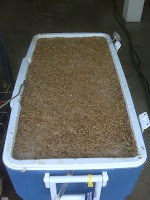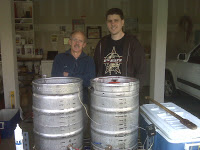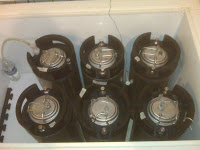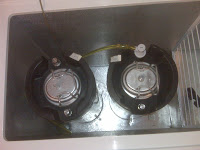Since all of the fermentors are at Mark’s house, he’s keeping an eye on things. Fermentation has slowed down or stopped for most. He gave the kegs a quick roll to rouse the yeast, since some are very flocculent. He also raised the temp to 72F for a couple days to perform a diacetyl rest, as some of these strains require.
 Yesterday’s brew day went well. First, I got the new pack of 1099 counted. It was still lower than it ought to be (67.6 billion viable cells, 98.5% viability), but enough for today’s brew.
Yesterday’s brew day went well. First, I got the new pack of 1099 counted. It was still lower than it ought to be (67.6 billion viable cells, 98.5% viability), but enough for today’s brew.Now a note on the recipe. Since we are trying to taste differences between the yeast, we went with a basic special bitter recipe that wasn’t too heavy on the hops. We picked a moderate starting gravity as well. Here’s the info:
I counted the number of cells in the four smack packs. Here are the results:
Sample % Viability Viable Cells/ml Total Viable Cells
Wyeast 1028 90.6 8.64e8 1.04e11
Wyeast 1098 97.7 7.83e8 9.39e10
Wyeast 1099 96.0 4.76e8 5.72e10
Wyeast 1882 98.3 1.22e9 1.46e11
The 1099 has only half the amount of cells it ought to – only 57 billion. So I bought another pack (and emailed Wyeast), and started another pack yesterday. Tomorrow is brew day, so I’ll count them in the morning, then get brewing.
I’m getting ready to embark on a mega-brewday with a couple guys from the homebrew club. We are going to make 8 3-gallon batches of a special bitter and ferment each with a different English ale yeast.
Here’s a list of yeast:
Wyeast 1026 PC British Cask Ale
Wyeast 1275 Thames Valley Ale
Wyeast 1768 PC English Special Bitter
Wyeast 1968 London ESB Ale (actually using White Labs equivalent WLP002)
Wyeast 1028 London Ale
Wyeast 1098 British Ale
Wyeast 1099 Whitbread Ale
Wyeast 1882-PC Thames Valley II Yeast
Check out wyeast.com for a description of the strains.
The 1026, 1275, 1768, and 1968/002 were grown up as 1-L starters from my glycerol stocks. In brief, ~5 ml of 1.040 wort was inoculated with a little bit of the stock and incubated at room temperature with intermittent shaking for several days. For each strain, a 1-L starter was inoculated with the 5-ml culture. (Note: I ran out of DME, so the starter gravity was 1.033) The starters were grown using a magnetic stir bar and stir plate at basement temperature (~64F) for 5 days. (Note from the morning of day 3 to the afternoon of day 4 there was no stirring due to outstanding circumstances) On day 5, a sample of each was taken and counted using a Beckman ViCell. Here are the results:
Sample Viable cells ml (x10^6) mL of starter
WLP002 122.62 706
Wyeast 1026 126.73 683
Wyeast 1275 86.56 1000
Wyeast 1768 158.85 545
The normalized amounts of the starters (87 billion cells total) were put into new bottles, and the yeast was allowed to settle.
Another note:
Both WLP002 and Wyeast 1768 were super flocculent and very chunky despite being stirred constantly. This made it very tricky to obtain a uniformed sample for counting.
As for the 1028, 1098, 1099, and 1882, these will be used with fresh smack-pack cultures. I activated the smack packs today, and I’ll let them incubate for a couple days at room temperature. Then I’ll count the cells, and normalize to 87 billion cells to be pitched. There ought to be plenty of healthy yeast in there for pitching without a starter.
Updates:
Brew day
Fermentation notes and bottling
Results of the tasting at our homebrew club.
Just found a case of Strawberry Mead the other day that I didn’t know I had. Rockin.
Been busy getting the house ready to sell, so haven’t had time to write about my Iron Brewer entry.
Every year Iron Hill in West Chester is kind enough to supply our homebrew club with wort containing mostly Pilsner malt. Then everyone who participates brews any style of beer they like. The only rule is you can only add 1 lb of fermentables. Any other specialty malts must be in a minimash.
This year I brewed a Belgian dark strong ale. The wort we received was Pilsner plus cane sugar. It measured about 1.075. Here’s my recipe:
Fermentable: 1 lb D2 candi syrup
Minimash: 1.5 lb caramunich (46L), 1 lb Aromatic, 0.5 lb Special B, 2 oz chocolate malt
Added grains to 1 gallon of wort, and kept at 155F for 30 min. Then drained the grains and batch sparged with 0.5 gal hot water.
Boiled for 75 min. Added 1.2 oz Cluster hops (7% AA) for 60 min, then 0.5 oz Saaz (4.2%) for 30 min.
Chilled overnight, and pitched Wyeast 1762 (~350 billion cells) to 58F wort after aeration by shaking for 5 min.
Fermented at 68-70F for three days, then moved up to 72F today. I’ll keep that at 72F for about 1.5 weeks.
I inoculated 2 1.6-L starters with Wyeast 1214 or Empire Brewing Company yeast for an upcoming beer. After the starter completed growth, the cells were counted using a Beckman Vi-Cell XR 2.03 automated cell counter.
The Wyeast 1214 was 282.11e6 cells/ml and the Empire was 132.86e6 cells/ml. Compare that to the Wyeast 1056 I did last time that came in at 85.8e6 cells/ml. There seems to be variation in the density of cells between yeast strains.
I’ve begun a new experiment examining how to best scale up a yeast starter from a glycerol stock, plate, or slant. Typically when starting from one of these storage methods, a 5-10 ml culture is inoculated. From there one can either pitch that culture into the final starter volume (typically 1-2 L). Alternatively, one can scale up the culture until the desired final volume is achieve, let’s say 5 ml to 100 ml to 400 ml to 1.6 L. I haven’t seen any hard comparison data showing one method is better than the other. I’ve made good beer by both methods, but I haven’t directly compared methods to determine whether there are flavor differences between them. Therefore, I have begun an experiment to do just that.
I am going to brew a blonde ale, and split the batch. To one half, I will add yeast from a one-step starter. To the other half I will add the same number of yeast from a step-starter. Then I’ll compare the flavor differences between the two.
Method
I’m going to make a 1.040 SG blonde ale. For each 2.5 gal halves, I will need to make 800 ml starters, assuming 1e8 cells per ml of starter, and pitching 7.8e10 cells per 2.5 gal.
On 26Oct2009 I inoculated 5 ml of 1.040 SG wort with a small amount of Wyeast 1056 glycerol stock. Kept at room temperature for several days, shaking several times a day.
On 29Oct2009, I made 1.6 L of 1.040 SG wort. After boiling and cooling, I split the wort into four parts. For the one-step starter, I filled a 2 L Erlenmeyer flask with 875 ml of wort. For the multi-step starter, I filled a 12 oz bottle with 50 ml, a 750 ml-bottle with 200 ml, and a 2 L flask with 625 ml of wort. Stored at 4C.
On 30Oct2009 I inoculated one 875 ml starter with 2.5 ml of the culture, and I inoculated one 50 ml starter with 2.5 ml of the culture. I added a stir bar to each, and stirred on stir plates.
On 01Nov2009, both cultures are growing. I stepped up the 50 ml starter to 250 ml by adding the 50 ml culture to the 750-ml bottle containing the 200 ml wort.
On 02Nov2009, stepped up the culture to 875 ml by adding the 250 ml culture to 620 ml wort in a 2 L Erlenmeyer flask. Put on stir plate and let it go.
Cultures had been going well for a few days now, and were probably winding down.
Yeast Count
On 05Nov2009 I counted the number of cells in both starters using a Beckman Vi-Cell XR 2.03 automated cell counter.
- One-step starter – 8.9e7 viable cells per ml, 96.4% viable
- Multi-step starter – 7.4e7 viable cells per ml, 94.2% viable
I continued the cultures stirring overnight to determine whether the cultures were finished dividing.
On 06Nov2009, I counted cells again.
- One-step starter – 8.6e7 viable cells per ml, 95.3% viable
- Multi-step starter – 7.3e7 viable cells per ml, 94.9% viable
The one-step starter had about 18% more cells than the multi-step starter. I doubt that this is significant, and I imagine if I repeated this several times I will see no significant difference in the cell numbers between the two starter methods.
Cultures were stored at 4C overnight to flocculate the cells.
Brew Day
I brewed an American blonde ale for this experiment, so that any differences in flavor between the starters can be easily detected. Here’s the recipe:
Malts:
Briess 2-row: 8 lbs
Weyermann Munich Malt: 0.75 lbs
Hops:
0.5 oz Cluster (7% AA) – 60 min
0.5 oz Czech Saaz (2.8%) – 30 min
0.5 oz Czech Saaz (2.8%) – 10 min
Starting Gravity: 1.042
Efficiency: 73%
Calculated SRM: 2.2
Calculated IBU: 19.2
Mashed at 152F for 1 hour with 1.25 qt water per lb grain. Collect 3.5 gal wort, batch sparged with 3 gal water at 168F. Boiled for a total of 1 h. Added whirfloc at 45 min.
Chilled wort, transferred to fermentor, and aerated by shaking for 15 min.
Split wort into 2.75-gal aliquots, and pitched equal numbers of either the single-step starter or multi-step starter.
On 21Nov2009 the final gravity of both was 1.010, yielding 76% attenuation. Therefore, in this experiment there was no difference in attenuation between the two starter methods.
I bottled with 2.5 oz dextrose, to give ~2.7 volumes of CO2 once carbonated.
Tasting
My wife and I did a blind tasting of the two batches of blonde ale. The beers were poured into three glasses per beer that were marked in such a way that they could be identified after the tasting, but not during. Then we each chose three glass randomly, each receiving two of one and one of the other. We then tasted to determine whether there were any perceivable differences, and to determine whether we could match the two glasses that were the same beer. The results were thus. Meredith correctly matched the same beer. She thought the single-step batch was more watery, and less flavorful. She found the multi-step batch to be more fruity. I incorrectly matched the beers. So, one can conclude that I could not distinguish the two batches. An overview of the beer: it has a malty aroma, with a subtle hint of hops. It has a medium-low body. There is a slight fruity flavor with some maltiness. No hop flavor. It’s a nice lawnmower beer, in my opinion.
Conclusion
Overall this was a nice experiment to see if there was a significant difference in the final beer using yeast grown from 2 different starter methods. I personally could taste no difference between the two, and will likely only use the one-step method in the future. However, this is the result of only one experiment, tasted by only two people. To really validate the experiment, it really does need to be repeated and the results tasted by a much larger panel.


